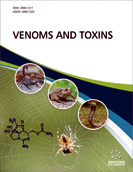
Full text loading...
We use cookies to track usage and preferences.I Understand
Background: Androctonus mauretanicus (Am ) is one of the most hazardous scorpions in Morocco and has a highly toxic venom responsible for severe cases of envenomation. However, few studies have focused on deciphering its proteic composition.
Objectives: Herein, we aim to map out the complete proteome of the Am venom filtrate to highlight its complexity and the polymorphism of its toxic content. This, in turn, will lead to a deeper understanding of the toxins’ mechanism of action and will help uncover those with therapeutic potential.
Methods: Top-down and bottom-up proteomic approaches were used complementarily to decipher the proteome of the Am venom. These approaches were carried out on nano-high liquid chromatography coupled to nano-electrospray tandem mass spectrometry (Nano-LC-ESI-MS/MS).
Results: Am venom encloses a complex mixture of 269 different compounds with molecular weights ranging from 1618.74 to 14 214.84 Da. The most abundant ones showed masses from 6185.92 to 7899.53 Da (53.89%) followed by those ranging from 2079.25 to 5969.63 Da (37.81%). Interestingly, the combination of the results of both approaches allowed the screening of a total of 112 peptides. The highest percentage was represented by neuropeptides (87%), including NaTxs, KTxs, ClTxs, venom proteins, venom neuropeptides, and myotropic neuropeptides. Moreover, other peptides were identified, such as antimicrobial peptides, amphipathic peptides, cysteine-rich venom peptides, enzymes, kunitz-type inhibitors and orphan peptides.
Conclusion: The Am venom appears to contain a great number of diverse peptides, some of which could prospectively be exploited for their pharmaceutical potential.

Article metrics loading...

Full text loading...
References


Data & Media loading...
Supplements

